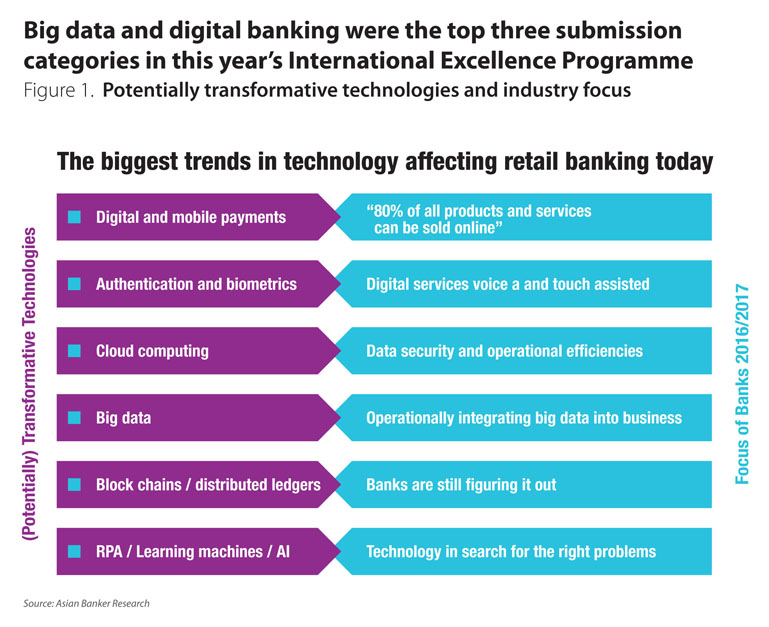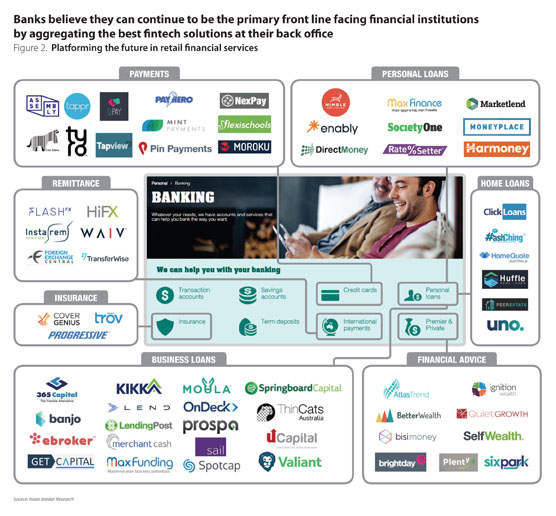- Banks are moving more products and services on their digital platform to get acquired fully straight-through processes
- An increasing number of banks spin off their digital only banks as legacy infrastructure not fit for digital future
- In emerging markets, financial institutions are moving fast to introduce end-to-end digitised services
Executives in retail financial services are reeling under the forces of disruption. They often have to prove to their board and shareholders that they are ahead of the curve, ahead of the client and ahead of financial technology (fintech). These demands are accentuated across an ever wider interconnected circle of businesses ranging from wealth management to payments and collaborative partnerships among regulators, fintech and banks. Industrial boundaries once clearly demarcated between telcos, banks, technology providers are ossifying. In their effort to change, banks put a lot of gunpowder into digital transformation.
Large banks in Asia and the Middle East continue to invest between $50 to $100 million a year on digital technologies, aiming to bridge the gap between their services and their customers’ digital footprint. But to move large financial institutions, executives have to pull the levers incredibly hard. They are trailing technology companies such as in China which are digitally disrupting the payments industry at a scale that makes banks shudder. Alipay and CreditEase, which has become the world’s largest peer-to-peer lender with $6 billion business on its portfolio, have demonstrated to incumbants that there are new markets with huge revenue and fee income to tap into without the need of banks as intermediaries.
Focus of banks in the excellence programme
From the submissions we receive we are able to gauge what banks are focusing on in their operations and businesses (Figure 1). Projects that can simplify front and back office working processes, and also bring customers a much more seamless digital experience were most prominent. Banks are moving more products and services on their digital platform to get acquired fully straight-through processes. This is done so increasingly for new-to-bank customers to allow processing the entire application, including uploading of supporting document, via web or mobile, and with the convenience of resuming the process any time later. Customers can obtain their credit score and decision of credit loan application within minutes. This is increasingly facilitated by digital signature and ID authentication, big data and artificial intelligence (AI). Executives we spoke to in Korea, Japan and Australia believe that up to 80% of all products and services can be fully offered digitally in the future. Based on our programme, top banks (mature markets) handle on average 17% of products digitally end-to-end.

This year’s excellence programme also revealed a spectre of responses ranging from defiance to fearing total disruption. But majority of banks have come to believe that the fear of displacement by fintech is not the real game. More than ever, they are aware of the power of their own universal retail financial services brand and franchise. Banks not only own the primary lever of people’s trust when it comes to their personal finances, but they also command a large, often untapped client pool. So, why should banks care anyway?
Creating financial ecosystems
The real concern is losing grip in understanding the shift in how customers consume and acquire financial services. Consumption patterns are moving further into alternative platforms such as Netflix, WeChat, Alipay and other messaging and social media platforms, requiring a review on how banks look at non-branch network management. Alipay and WeChat Pay in China have shown that the convergence of messaging apps and the integration of micropayments into people’s lives is a powerful combination in creating total payment ecosystems – a term which is gaining traction in the banking industry (Figure 2). In fact, one key emerging focus banks have begun discussing with us in excellence is creating “ecosystems” which they hope are much harder to replicate.

This implies not only creating lifestyle ecosystems for customers that go beyond mere product selling but also to play, compete and cooperate within a wider network of fintechs, regulators, e-commerce platforms and nonbank financial institutions. The rise of cross-sector digital partnerships will not only be opening new revenue sources, but also harness big data to reconstruct more accurate customer identities for authentication, know your customer (KYC) and credit scoring.
To create those ecosystems, banks need to better harness network effects to allow customers to easier access a broader range of products and services outside the banks’ traditional digital channels, and to collaborate with third parties to develop and market an increasing number of product variants through open application program interface (APIs). It also means to transform the value price relationship, much like what Amazon Web has done by shifting pricing from fixed, upfront pricing to performance- and usage-based pricing and unbundle product and services to tailor-make it for clients or client segments’ specific needs. The Asian Banker Research has seen first steps in these directions among the leading banks in Asia, Africa and the Middle East, but the vast majority has yet to take on this future.
Legacy infrastructure has proven a key drag. Creating something totally new within existing frameworks has proven limited posed by the scale and cross-integration of back-end systems, which in turn gives less room and time to innovate. The question banks ask themselves is what is the model going forward that will be allowed by regulators and, eventually, adopted successfully by customers.
Some banks opt to spin off the mobile-only platform altogether, with a different core banking system and management team such as Bank of Tokyo-Mitsubishi UFJ (BTMU) and KDDI in Japan which formed its mobile-only Jibun Bank in 2012. Regionally, more banks launched this model in 2016-2017, such as Shinhan Bank Korea (“Sunny Bank”), Emirates NBD (“Liv”) and DBS Singapore (“Digibank”).
We have also observed that banks intensifying their focus in digitising small- and medium-sized enterprises (SME) banking to improve resource allocation, increase cross-sell and offer better customer experience. UOB Singapore launched a cloud-based BizSmart suite of integrated solutions to help SMEs with a number of their needs including enterprise resource planning (ERP) and supply chain management and HDFC India launched SMe Bank, a fully digital SME bank allowing clients to access a full range of services instantly. It is supported by an end-to-end automated workflow system and fully interfaced with the back end loan, deposit, credit cards and accounting systems and analytics. The bank increased the portion of digital transactions by 25%.
Creating a digital sales platform
In emerging markets, financial institutions are moving fast to introduce end-to-end digitised services.
Since 2015, Vietnam Prosperity Bank has built up a substantial position in the consumer finance market with a market share of 60%. The bank initially launched online origination for leads generation, but has moved quickly into an end-to-end digital process, including online disbursal, which is fully integrated with the credit bureau and its core banking system to allow certain segments to approve loans in under ten minutes. The bank expects between 40% and 60% of all new bank applicants to be processed with this fully automated process. In the same vein, CIMB Malaysia originates and processes close to 50% of all consumer finance loans via digital channels. Its web and mobile platforms are fully integrated and systems are integrated directly to the host system and transactions are processed on a straight-through basis.
2017 will also see the spilling over into digital current account opening and remote deposit generation. From paper-work, multiple signatures and having to access dozens of systems, the relationship opening experience at branches varies by markets and even within the same bank. In its efforts to standardise and automate the back and front end processes further, banks reduce account opening time to a a few minutes and afford more time for the relationship manager to engage with the customer. Most Australian banks are already offering those options, but an increasing number of banks from the United Arab Emirates (UAE) to Taiwan are working on this. CTBC Taiwan offers conventional account opening at the branch within 15 minutes, including filling forms, KYC and document processing. The bank uses optical character recognition (OCR) identification technology for identity card scanning, and automatically detect column information through imaging in the application form. In 2016, the Taiwanese bank launched online account opening in four steps, including the uploading of certification documents.
The digital sales funnel
To ensure this, online form interface and user experience must be easy, simple and mobile responsive, so that prospects do not drop off mid-way. Yet, banks continue to deploy too many pages and clicks in the application process. A digital sales funnel exists of three major steps: clicks on sales prompt, including static or dynamic sale prompt buttons/messages, application submitted and approval. With this process, banks face major issues, such as the low conversion rates from digital offers into clicks on sales prompts indicate that banks continue to target the wrong customers, at the wrong time, with the wrong offers (Figure 3). High page load and data fields, no provision of assisting information, or access to instant customer support are major causes of low of high drop-offs in the mid-funnel of application.
.jpg)
While the entire process of designing and developing the user experience is increasingly stewarded through principles of design thinking and human-centred design, using UI/UX principles as a stand-alone tool without the power of digital analytics is not effective. Yet, most banks do not even have the capacity to measure critical control points in the digital sales funnel.
Big data
Banks in our programme aim for greater personalisation of customer experience by better understanding their situation and what they are trying to achieve. A more timely understanding of customer interactions with the bank, however, requires collecting and interpreting a variety of data types in real-time and at scale, a trend which is, nascently though, unfolding. Leading banks have completed their investment into multi nod and multi core big data and computing platforms in combination with more traditional data mining and business intelligence infrastructure, which enables them not only to migrate high-cost enterprise data warehouse activities to lower cost platforms, but also to stream large scale unstructured data such as voice, click stream data, picture/social media.
Generally, banks have deep information on customers who have strong relationships, with details dropping off for customers with lighter relationships. The goal is to identify key changes in customers’ circumstances such as the birth of a child, household formation/dissolution or changing jobs, in a timely way so that banks can pro-act to assist the customer. Rich transactional data tells the banks about these events after the event, for example, changing jobs as detected by change in salary details. The challenge for banks, as we observed, is putting a jigsaw puzzle together without seeing the picture on the box. In data terms, without the pieces of the puzzle no amount of computation or technique will yield the answer.
Banks can already leverage streaming of real-time information within some of its decision-making processes, reducing the time to get insights from weeks to seconds. They are able to gain insights on what is driving traffic through, for example, the contact centre with real time voice to text analysis, and subsequently, make inferences about customer needs with the effect to better manage relationships. Other emerging applications are the adoption of location-based offers (LBO) and real-time triggers in particular in the credit card business. Best-practice banks are already able to combine location and preference data to increase engagement by sending the most relevant credit card offers to customers. Admittedly, much of the success depends on the underlying algorithms and predictive models.
Banks in Singapore and Australia launched realtime location-based SMS campaigns, which leverage streaming credit card transactions to identify the current location on customers. It combined location informatio with the individual customer profile to identify relevant offers within the customer’s vicinity and the message generation occurs within seconds of the original card swipe. The result generated significantly higher response rates. At Westpac, by analysing retail data of collections of customers that had the same three accounts or products in the same order for the same reasons, yet if one of the three had only two of those products, there was a very high (90%) chance of them taking up the last product in time. Knowing this, Westpac created an alert in their system so that their tellers could mention the third product to the customers who had demonstrate this particular buying pattern. This small adjustment resulted in a 40% conversion rate on the offering of the third product.
In other areas, banks focus on customer attrition, audit, employee attrition, training and customer pain points, such as web or mobile experiences that are causing customers to contact the call centre.
Improving prediction through data-augmentation and extension, collaborative business intelligence not only applies to enterprise-wide reporting and analytics now, but other ecosystem players will also soon become critical. National Australia Bank, Westpac and Qantas in Australia have invested $10.5 million by the end of 2016 in Sydney-based start-up Data Republic, which is aiming to build a marketplace for data exchange between major corporations. Also, with the scale and scope of customer data being harvested, cyber security, data privacy and ownership of those data between customers, regulators, banks will increasingly move to the fore.
Authentication and biometrics
Biometric authentication, which enables a full range of services, is becoming mainstream. The deployment of multispectral fingerprint authentication, which scans several layers of the skins and facial recognition are emerging not just any more for consumer enrollment or authentication at the automated teller machine (ATM), but across the whole spectre of human ID, in customer teller interaction at the branch or employee authentication to banking applications and systems. User ID and password are quietly being phased out. Citibank Hong Kong with its “Touch ID Sensor” is one of the few banks to allow customers using their fingerprints to access all functions of the mobile app.
Digital services are currently being developed to support natural language processing to become voice assisted, Siri by OCBC Singapore and Capital One in the US with Alexa, are other good examples in this direction. OCBC Pay Anyone which is an account-to-account mobile payment service that does not require the sender to know the recipient’s bank account details to make a payment. The bank integrated the payment app with Apple’s Siri and iMessage features making it one of the firsts to do so in the region. Siri is Apple’s built-in “intelligent assistant” that enables users to operate their apps via natural language voice commands. Capital One in the US is another early entrant into the game. The bank created a virtual assistant application - or ‘skill’ - for Amazon’s Alexa platform. The voice-activated service allows for more than 150 query types, ranging from tracking recent transactions on credit and current accounts to bill payments. Capital One is currently the only US-based financial institution using Alexa amid industry observations that the convenience of the technology has not caught up with expectations.
Can banks remain the gateway for retail financial services?
Banks ponder how to position themselves in the best possible way to play in this financial ecosystem. Fundamentally they are seeking collaboration in this ecosystem and believe that banks continue to be the gateway for financial services.

































